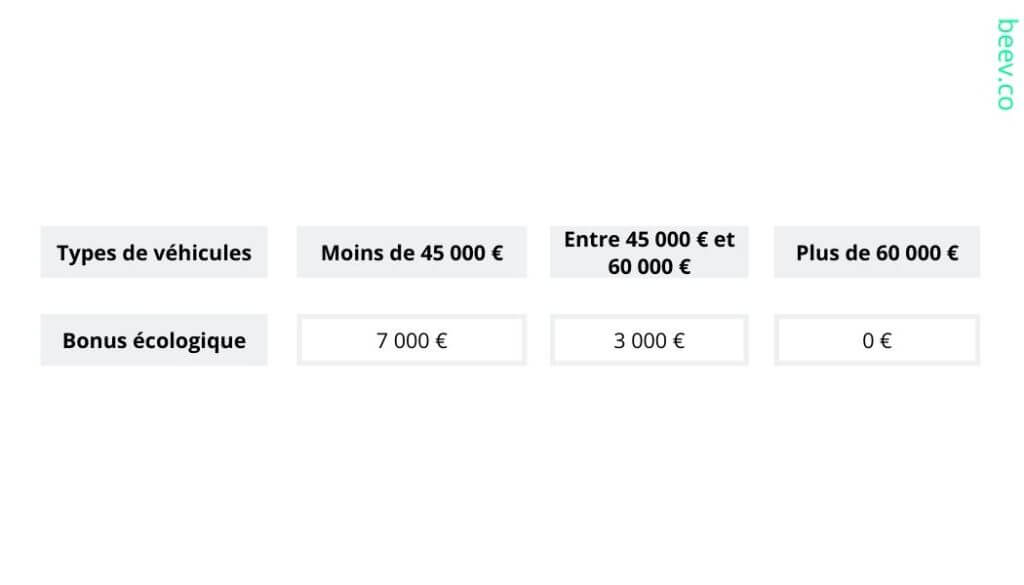Compare these two electric cars
With our tool electric vehicle comparator you can compare the :
Reminder: definition of TCO (total cost of ownership)
Let's start with a quick definition of the term "total cost of ownership". Translated into French, this term literally means "total cost of ownership" and, as its name suggests, it is an indicator of how much an object or service has cost you over its lifetime.
Why is this an important calculation? Quite simply because we tend to make decisions based on the price of items or services only at the time of purchase. But we rarely take into account the total cost of ownership.
In the case of vehicles, this calculation can help you save thousands of euros. To get the real picture, we've decided to compare two vehicles: a thermal vehicle (the Nissan Qashqai) and an electric vehicle (the Nissan Leaf).
Nissan Leaf vs Qashqai: Calculation methodology
The following components must be taken into account when calculating TCO (total cost of ownership):
- Purchase price
- Electric car charging point
- Support available for each model + taxation
- Fuel and energy consumption
- Vehicle taxes
- Car insurance
- Maintenance and servicing
- Residual value
Nissan Leaf vs Qashqai: What this calculation doesn't take into account
This calculation does not take into account several criteria such as :
- Fluctuating hydrocarbon prices: The price of fuel is increasingly taxed in France, and we are not immune to price rises. As the price of a barrel of oil also depends on geopolitical parameters beyond the control of our governments, it is complicated to anticipate the future supply of hydrocarbons and therefore their price.
- Car park savings : electric cars also mean free parking in some towns. So as not to generalise, we have chosen to exclude this benefit from the calculation of TCO (total cost of ownership).
- Reducing noise pollution: Electric cars don't make any noise, which is very soothing for the driver, especially if you spend a lot of time in them. Imagine living for years in front of a boulevard and then suddenly installing double-glazed windows? It's the same thing.
- Reducing CO2 emissions : It's a shame, but this criterion is not taken into account when calculating the TCO of an electric or petrol vehicle. Yet this parameter is crucial today, given the determination of governments to reduce pollution in their countries.
Discover several models of electric vehicles that can be delivered quickly!
1. Purchase price
Your Nissan costs around €36,417Leaf 62kWConnecta while the NissanQashqai1.3DIG-T 140 Visiacosts just €24,950.This means that the electric version is around 33 % more expensive than the petrol version.
| Nissan Leaf 62 kW Connecta | NIssan Qashqai 1.3 DIG-T 140 Visia | |
|---|---|---|
Catalogue price excl. | 36 417 € | 24 950 € |
2. Charging station for the Nissan Leaf
In the case of the Nissan Qashqai, you still have to fill up at the petrol station. But in the case of a Nissan Leaf, it's strongly recommended that you install a charging point at home. This gives you greater flexibility when you're driving, and you can recharge safely at home or at your business.
A wallbox costs between €500 and €1,500. You can also recharge your battery at work. In both cases, there are a number of grants available to help you benefit from reductions linked to the installation of recharging points, whether you live in co-ownership or in detached house. Whether you rent or own your home, you have the right to a plug that allows you to recharge your battery at home. That's your right.
3. Aid for the purchase of an electric vehicle
If you buy the Nissan Qashqai, you pay a ecologic malus 70 in 2019.
Good to know: in 2020ecological penalty amounts soar. Don't hesitate to read our special report on this subject.
In the case of the Nissan Leaf, on the other hand, a number of grants are available for buyers of electric vehicles.
The ecological bonus
Le environmental bonus only applies to 100 % electric vehicles. The amount is 27 % of the acquisition cost of the vehicle, including VAT, up to a maximum of €7,000. In 2020, new rules will apply for the award of the environmental bonus.

The conversion premium
The conversion premium is a government scheme that enables low-income households to scrap their old car in favour of a less polluting model in return for financial assistance.
Also read - Conversion premium
| Prime à la conversion | Véhicule électrique neuf | Véhicule électrique d'occasion |
|---|---|---|
Company | 2 500 € | 2 500 € |
Reference tax income exceeds 13,489 euros per unit | 2 500 € | 2 500 € |
Reference tax income is less than 13,489 euros per unit | 5 000 € | 5 000 € |
Regional aid
Depending on where you live, you may also be eligible for other grants that can be combined with the environmental bonus and the conversion premium.
See also - Regional aid for electric cars
If you're buying a petrol car, you'll have to forget about any purchase aid.
4. Nissan Leaf vs Qashqai: Fuel
When it comes to fuel consumption, the Nissan Leaf has a head start over the Nissan Qashqai. An electric car costs around €2/100 km, much to the delight of electric vehicle enthusiasts.
Petrol vehicles are a different story. The Nissan Qashqai 1.3 DIG-T 140 Visia consumes 5.5 litres of petrol per 100 km (combined cycle) at an average price of around €1.50 per litre in France (i.e. 8.25/100 km, 4 times more than an electric vehicle).
If you drive 24,000 km a year, you save over €800 a year. As you can see, the more you drive, the more profitable an electric vehicle will be for you.
| Nissan Leaf | Nissan Qashqai | |
|---|---|---|
Finish | 62 kW Connecta | 1.3 DIG-T 140 Visia |
Fuel costs | - | 1,5 € |
Average fuel consumption (L/100 km) | - | 5,5 |
Cost €/100 km | 2 € | 8 € |
Number of kilometres travelled per year | 24 000 | 24 000 |
Fuel cost per year | 480 € | 1 954 € |
5. Nissan Leaf vs Qashqai: Vehicle taxes
If you buy an electric car as a private individual or as a company, you will benefit from the environmental bonus and you pay very low registration fees.
If you're buying a Nissan Leaf as a business:
- You pay €0 taxon the use of passenger vehicles for economic purposes
- The registration fee will be €3 (in Paris)
- Amortisation tranche of €30,000 in 2019 and 33,000 in 2020
For the Nissan Qashqai, the costs are different:
- You pay €806/year for taxis on the use of passenger vehicles for economic purposes
- Registration fees will be €354 (in Paris)
- Amortisation tranche of €18,300 in 2019
| Nissan Leaf | Nissan Qashqai | |
|---|---|---|
Finish | 62 kW Connecta | 1.3 DIG-T 140 Visia |
Amount tax on the use of passenger vehicles for economic purposes per year | 0 € | 806 € |
Amount of tax on the use of private cars for business purposes over the term of the contract | 0 € | 3 224 € |
Vehicle registration document | 3 € | 354 € |
Total | 3 € | 3 578 € |
6. Nissan Leaf vs Qashqai : Car insurance
Another factor to consider when calculating the TCO of an electric car is insurance.
The price of insurance is based on a number of criteria: the model, the tax rating of the vehicle, the place of residence, and individual factors such as the number of years of insurance cover. bonus/malus and the driver's experience.
For comprehensive insurance, you'll need to pay around £819 for a Nissan Leaf and £800 for a Nissan Qashqai. So when it comes to insurance, there's not much difference between the two models.
| Nissan Leaf | Nissan Qashqai | |
|---|---|---|
Finish | 62 kW Connecta | 1.3 DIG-T 140 Visia |
Insurance price per year | 819 € | 800 € |
7. Nissan Leaf vs Qashqai: Servicing and maintenance
Servicing and maintenance are also components in the calculation of vehicle tco.
For petrol cars, this includes changing the engine oil and replacing the brake fluid. The price for the Nissan Qashqai is around €800 a year.
In fact, vehicles fitted with combustion engines have many more wearing parts than vehicles fitted with electric motors, which naturally leads to higher repair and maintenance costs.
This difference gives the electric car a significant advantage: maintenance is much cheaper and less frequent. The Nissan Leaf costs around €240 a year. Note that the battery is the most critical component to maintain, unlike a combustion engine vehicle.
Good to know: electric car batteries are guaranteed for up to 8 years by the manufacturer.
| Nissan Leaf | Nissan Qashqai | |
|---|---|---|
Finish | 62 kW Connecta | 1.3 DIG-T 140 Visia |
Maintenance cost per year | 240 € | 800 € |
8. Nissan Leaf vs Qashqai: Vehicle residual value
The final criterion to compare when calculating the TCO (total cost of ownership) is the residual value. The residual value is the value of the vehicle on the second-hand market after it has been used.
Estimating the residual value of your vehicle can be quite complicated, especially for someone who doesn't work in the motor industry. But there are websites that allow you to simulate the residual value and help you make your choice. For example, you can use Autovisual for free simulations. The site is available in several countries, including Belgium, Luxembourg and Canada.
Throughout this article, we have estimated that the two cars travel 24,000 km per year, or 2,000 km per month.
The residual value of the Nissan Qashqai is lower than that of the Nissan Leaf.
Why the price difference? With legislation gradually being passed to tax the most polluting vehicles, it is likely that combustion-powered cars will be less in demand on the second-hand market and will sell less well.
| Nissan Leaf | Nissan Qashqai | |
|---|---|---|
Finish | 62 kW Connecta | 1.3 DIG-T 140 Visia |
Theoretical resale price excl. | 16 667 € | 10 000 € |
Conclusion: Which car costs less in terms of TCO?
After 4 years, the verdict is clear: electric cars cost much less than their internal combustion counterparts. The an internal combustion car will cost you twice as much as an electric car.
The table below compares the overall costs of the two vehicles after four years.
| Nissan Leaf | Nissan Qashqai | |
|---|---|---|
Finish | 62 kW Connecta | 1.3 DIG-T 140 Visia |
Purchase price | ||
Catalogue price excl. | 30 873 € | 24 950 € |
Ecological bonus (private individuals) | - 7 000 € | 70 € |
Vehicle registration document | 3 € | 354 € |
Price after discount | 24 876 € | 25 374 € |
Charging station | ||
Wallbox installation | 600 € | 0 € |
Tax on the use of passenger vehicles for economic purposes | ||
Amount of tax per year | 0 € | 806 € |
Amount of tax over the term of the contract | 0 € | 3 224 € |
Total | 25 476 € | 28 598 € |
Cost of use | ||
Fuel costs | - | 1,5 € |
Average fuel consumption (L/100 km) | ||
Cost €/100 km | 2 € | 8 € |
Number of kilometres travelled per year | 24 000 | 24 000 |
Fuel cost per year | 480 € | 1 954 € |
Maintenance cost per year | 240 € | 800 € |
Insurance price per year | 819 € | 800 € |
Number of years before reselling the vehicle | 4 | 4 |
Utilisation costs over the period of ownership | 6 156 € | 14 214 € |
Theoretical resale price excl. | 16 667 € | 10 000 € |
Total cost of ownership before resale | 31 632 € | 42 812 € |
Total cost of ownership per year excl. | 7 908 € | 10 703 € |
Total cost of ownership after reselling the vehicle excluding VAT | 13 965 € | 32 812 € |
Use the TCO simulator to calculate the total cost of ownership of your car and compare it with its internal combustion equivalent.
































